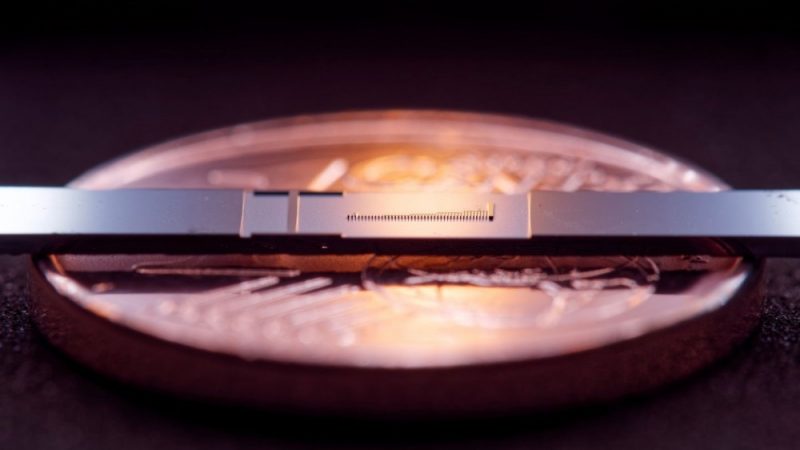How physicists built the world’s smallest particle accelerator

If you think of a particle accelerator, what may come to mind is something like CERN’s Large Hadron Collider (LHC): a multibillion-dollar colossus that’s dozens of miles wide and crosses international borders in the name of unlocking how the universe works.
But particle accelerators take many forms. There are more than 30,000 accelerators in the world today. While some of them—including LHC—are designed to unveil the universe’s secrets, the vast majority have far more Earthly purposes. They’re used for everything from generating beams of brilliant light to manufacturing electronics to imaging the body and treating cancer. In fact, a hospital can buy a room-sized medical accelerator for just a few hundred thousand dollars. And, as of last month, scientists have made another curious addition to the list: the smallest particle accelerator yet.
Physicists have fabricated an accelerator the size of a coin, publishing their work in Nature on October 18. This device is just a tech demo, but its creators hope it opens the gateway to even smaller accelerators that could fit on a silicon chip.
“I consider this paper to be really interesting and cool physics, for sure, and it’s been an effort that’s been going on for a long time,” says Howard Milchberg, a physicist at the University of Maryland, who was not involved with the research.
[Related: The green revolution is coming for power-hungry particle accelerators]
This mini-accelerator is not merely a Lilliputian LHC. Depending on its operational calendar, LHC fires protons or the nuclei of lead atoms around a large circle. This miniaturized accelerator instead fires electrons down a straight line.
Plenty of other linear electron accelerators have existed, including most famously the now-dismantled two-mile-long Stanford Linear Collider. Traditionally, electron accelerators boost their projectiles by shooting them through metallic cavities, typically made from copper, that contain twitching electromagnetic fields. The chambers thus push particles along like surfers on electric waves.
But some physicists believe that these old-fashioned accelerators are not ideal. The metallic cavities are prone to errors. They’re also unwieldy and require large equipment. The researchers’ new accelerator instead uses precise laser shots to push the electrons.
Physicists have been trying to make laser accelerators since the 1960s. Called photonic accelerators, referring to the study of light, they can be smaller and more cost-efficient than their cavity-based counterparts. But only in the past decade have lasers become precise and affordable enough for even experimental photonic accelerators to be practical.
Making them smaller, then, brought its own series of daunting obstacles. A major stumbling block had been the fact that engineers didn’t have the sophisticated technology needed to craft a mini accelerator’s tiny parts.
Take the coin-sized accelerator the researchers tried to build. First, it generates electrons using a part repurposed from an electron microscope. Then, the device pushes the electrons down a colonnade: two rows of several hundred silicon pillars, each just 2 micrometers tall, with an even smaller gap between the rows. A laser strikes the top of the pillars, creating electric fields that boost the electrons squeezed inside—at least on paper.
“Making such small features with enough precision is extremely demanding,” says Tomáš Chlouba, a physicist at Friedrich-Alexander-Universität Erlangen-Nürnberg in Germany, and one of the paper’s authors. “You need really top-of-the-line devices…these are not cheap devices, and these are not devices that were available in the 90s.”
[Related: Scientists found a fleeting particle from the universe’s first moments]
But chip fabrication is always advancing. Now, Chlouba and his colleagues could rely on techniques that are already common in the world of semiconductor manufacturing. They fashioned a successful prototype. The device can deliver only about 1 electron per second, a tiny trickle by particle accelerator standards. (The average wire inside the average device in your home carries quadrillions of times more electrons.) Moreover, the electrons have about the same energy as those inside an old-style cathode ray tube television: again, a pittance by particle accelerator standards.
As a result, “I don’t know how practical it could be,” says Milchberg. Fitting more electrons down the colonnade would be like hitting a bullseye with a shotgun blast, he says.
Indeed, Chlouba makes it patently clear that he and his colleagues are very far away from using this accelerator for anything resembling a real-world application. If they want to do that, they’ll need to make many more electrons, with much higher energies. Milchberg says it is also not clear if batches of electrons can fit together down the colonnade without their negative electric charges pushing them apart.
But if researchers succeed at overcoming these hurdles, Chlouba could imagine a host of applications for particle accelerators that could be arranged on a standard silicon chip. Medical professionals already use electron accelerators to treat skin cancer. With that in mind, some doctors might imagine an accelerator that is small enough to insert inside the body via an endoscope. “This is smaller, cheaper, and fits everywhere,” Chlouba says.










